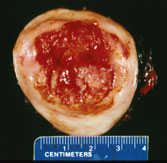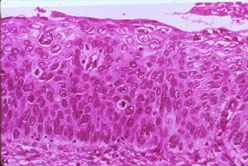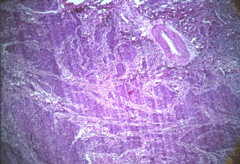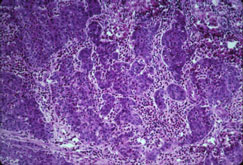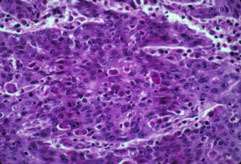|
|
 |
 |
|
16. CERVIX UTERI: SQUAMOUS CELL CARCINOMA
PERTINENT CHANGES:
The epithelium is interrupted in one area by a massive overgrowth of epithelial tumor cells which extends deep into the wall of the cervix.
The epithelial tumor cells are arranged in sheets and vary considerably from normal squamous epithelium.
The nuclei vary in size, shape and staining character. The nucleocytoplasmic ratio is altered in favor of the nucleus.
Loose and dense bands of connective tissue are seen. These contain lymphocytes and plasma cells.
In one area the epithelium shows an intact basement membrane. Here the nuclei of all of the cells show a variation in their size, shape and staining character (carcinoma in situ).
|
 |
 |
|
16A. "See Pathology, Rubin and Farber, 2nd edition; Figure 18-12, p. 924." |
|
|
 |
 |
 |
 |
 |
 |
|
16B. Gross view of cervix with an ulcerative carcinoma occupying the transformation zone and extending from it to the portio vaginalis |
|
|
|
16C. High power of an area of severe dysplasia (high grade squamous intraepithelial lesion) with atypical squamous cells extending to the surface, but with an intact basement membrane (no invasion). |
|
|
|
16D. Low power of invasive squamous cell carcinoma with irregular sheets of atypical squamous cells invading the surrounding stroma |
|
|
|
16E. Medium power of view 16D. A mark of invasiveness is an inflammatory response, here manifested as lymphocytes and eosinophils |
|
|
|
16F. High power of the invasive tumor showing nuclear pleomorphism with enlarged nuclei leading to an increased nuclear-cytoplasmic ratio. Cytoplasm of a few cells shows evidence of keratinization. |
|
|
